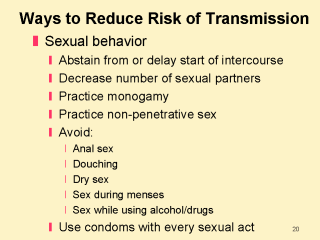 |
There are
a number of ways to reduce the risk of sexual transmission of HIV. Delaying the start of
sexual activity, lowering the number of lifetime sexual partners, practicing monogamy and
abstaining from sexual activity all will help reduce the risk of both HIV infection and
other sexually transmitted infections. Non-penetrative sex or mutual masturbation can be a
safer and satisfying alternative to intercourse. Certain practices, such as anal sex; dry
sex in which herbs or other substances are used to dry the vaginal mucosa; and douching
may increase trauma and irritation to mucosal surfaces, possibly increasing infectiousness
and susceptibility. Sex should be avoided during menses because it has been found to
increase both infectiousness and susceptibility; Furthermore, use of alcohol or drugs
increases the prevalence of unsafe sexual practices. Perhaps the best way to reduce the
risk of sexual transmission is by using a condom with every act of sex. |
